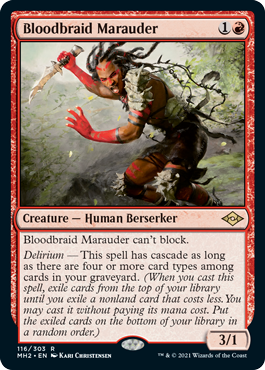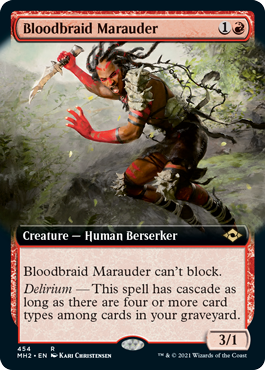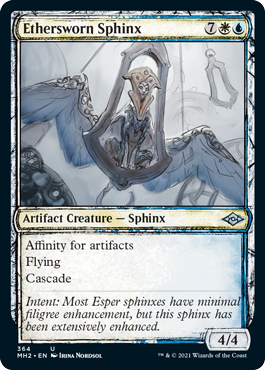A Modern Approach, Part 2
Welcome to our second week of Modern Horizons 2 previews. Last week, I told you the story of the vision design of the set. Today, I will introduce you to the Set Design team, walk you through what they did, and show off two cool new preview cards. (They have a theme that I like as much as Squirrels—and that's saying something). I hope you are all as excited as I am!
To begin, I'm going to have Aaron Forsythe, the lead set designer, introduce you to his team. (Note—I'm introducing Aaron, and the rest of the bios are written by Aaron.)
Click here to meet the Set Design team
Aaron Forsythe (lead)
There are few people who embody the spirit of a Modern Horizons set like Aaron. Not only has he played Magic for most of its life, but he was also a member of the Time Spiral design team, the set that inspired Modern Horizons. Aaron is the vice president of Magic design, so he doesn't get the chance to work on a lot of design teams, let alone run one, so it speaks volumes that Modern Horizons 2 is the set Aaron chose to lead. As you'll see during previews, Aaron, along with his design team, understands what makes Modern Horizons so much fun.
The rest of these bios are written by Aaron.
Corey Bowen
Corey is primarily a vision and Commander designer, but I was happy to have him on the team as he is a constant source of charm and whimsy. Corey is always good for a bunch of designs that are both funny and fun, which I appreciate and prioritize when making a set. You can thank him for the cadre of coin-flip cards in the set.
Jadine Klomparens
Jadine, a member of our Play Design team, was awesome to have as a team member for a couple reasons. One, she can keep massive amounts of information in her head and recall details of hundreds of individual ever-changing cards. Two, she has a real knack for knowing what makes Limited decks work and would always suggest perfect, subtle tweaks to cards that would make night-and-day differences.
Michael Majors
Michael is an awesome deck builder and Constructed Magic theorist and was always the one who could best contextualize the things we were doing in the set within the larger framework of Modern. He was also one of the toughest team members to please. I can recall multiple instances where I'd pitch a design, and Michael would calmy furrow his brow, effectively a death sentence for the card in question.
Dan Musser
Dan had been on Ethan Fleischer's Vision Design team with me and joined the Set Design team late in the process before we spun up the Future Future League (FFL). Dan had worked a lot on the playtesting of Modern Horizons as his first assignment at Wizards, and he was champing at the bit to dive back into developing Modern content. Dan co-led the FFL, and in the time since, he's become the manager of the whole Play Design team.
Ken Nagle
While the product may have "Modern" in its name, the Commander audience was definitely on our minds as we were building it, which meant we needed some Commander perspective on the team. Ken is a true veteran designer but retains a youthful exuberance when it comes to making cool and fun Magic cards. He is also a walking encyclopedia of previous designs, which is a must-have when doing a nostalgia-focused set.
Ryan Printz
Because Modern Horizons 2 is not part of MTG Arena's content plan, the Magic Online team was our primary digital client. Ryan, one of MTGO's software developers, was added to the team to keep an eye on us. I anticipated him simply being the bad cop, calling out designs for having bad UX or rules implications, but it was quite the opposite. Ryan's intimate rules knowledge gave him a unique design perspective, and he came up with all kinds of clever and crazy designs that actually worked well digitally—exactly the kind of stuff the set needed.
Adam Prosak
Adam was the set design lead for the first Modern Horizons, so there was no way I couldn't have him on this team—his perspective was too valuable. Adam is excellent at structure and connective tissue and is quite grounded and pragmatic when it comes to solving problems. He kept our conversations from going too far off the rails.
Reggie Valk
Reggie worked on the team for a couple of months near the end of his time as a contractor, and his work on Modern Horizons 2 contributed to the ultimately easy decision to bring him on as a full-timer. Reggie is a voracious Magic player (as his Twitter feed shows) and is an amazing problem-solver. I look forward to many more years of Reggie's work.
The Future Future League
Musser and Majors co-led a team of contracted playtesters, kind of mini-FFL for Modern Horizons 2. The team was made up of Zac Elsik, Sam Black, Brian Braun-Duin, and Brad Nelson, which is a pretty stacked lineup of deck-building and playing talent. It was a real joy engaging with players of that level over this card set, and a lot of great changes—including several brand-new designs—came out of that effort.
Ready. . . Set
The original Modern Horizons had done a lot to create an identity for itself. Modern Horizons 2 mostly had to follow the same formula and build on it. Aaron and his team wanted to understand what Modern Horizons 2 was going to be doing differently than the original Modern Horizons.
Here are the major differences:
- Multicolor plays a larger role.
As I explained last week, to stay off the heels of Commander Legends, the original Modern Horizons design teams had limited how much multicolor was in the set. As this wasn't the case for Modern Horizons 2, vision design had upped the volume, both in number and as-fan (the percentage that a theme shows up in booster packs). Set Design set the number at ten commons, ten uncommons, with a bunch more at rare and mythic rare (counting just new cards, not reprints). They also included a 10-card cycle of dual lands at common to support the increased amount of gold cards.
- The reprints are treated differently.
In Modern Horizons, the reprints were just folded into the set. How many you opened in any one booster pack was at the whim of the collation. For Modern Horizons 2, Aaron and his team decided to give the reprints a dedicated slot, meaning every booster pack will have exactly one reprint (with an exception I will get to in a second). All the reprints in this slot have an expansion watermark of the set symbol with which they originally appeared. The exception to this is the cycle of five enemy fetch lands at rare that just appear on the sheet and aren't in the reprint slot. As a result, they don't have a watermark. This does mean, by the way, that you are able to open two rares in one booster, one normal and one from the reprint slot.
- The set has different Draft archetypes.
While the general sense of the two Modern Horizons sets is the same, we definitely wanted Modern Horizons 2 to focus on different mechanics, especially when it came to Draft archetypes. Here are the ten two-color pairs along with the thought that went into each theme, plus one extra archetype.
White-Blue – "Artifacts Matter"
Magic has had a lot of artifact themes and subthemes over the years, so this archetype plays into that. It made use of many artifact mechanics but focused specifically on affinity for artifacts and metalcraft, as both of those encourage a heavy artifact focus. Affinity for artifacts is a great example of something splashy and memorable that we'd have a difficult time fitting into a normal premier set.
Blue-Black – "Self-Discard Matters"
This archetype takes advantage of blue and black's ability to mill your own cards and then taps into a variety of different graveyard mechanics. Like artifacts, discard and graveyard are both themes that have shown up enough over the years that we can combine disparate cards to make something new.
Black-Red – Madness
As I explained last week, one of our goals for Modern Horizons 2 was to take some themes in Modern that needed a little extra help and dedicate some cards to it. Madness was one of those themes. As the majority of the relevant madness cards were in black and red (due to it being the major theme for Vampires in Shadows over Innistrad), it was made into the black-red Draft archetype.
Red-Green – Storm
I have an entire scale dedicated to explaining how unlikely it is for the storm mechanic to return to a premier set (you can learn more about the Storm Scale here), so this is definitely a theme that only a set like Modern Horizons could do. Aaron and his team were focused on finding mechanical themes like this that would help give Modern Horizons 2 a unique feel. Storm makes a lot of sense in red-green, the two colors most associated with mana production.
Green-White – +1/+1 Counters
This is another theme that got carried over from vision design. Basically, it involves using many of the mechanics we've made over the years that use +1/+1 counters. Green and white are the two colors most focused on +1/+1 counters, so it gave the team the largest pool of cards to work with.
White-Black – Reanimator
Reanimation is the third theme to make the transition from vision design. Like storm, it's a mechanic that's very tricky to make work in a premier set due to complexity and as-fan issues, both of which can be addressed in a higher-complexity supplemental product. The theme is focused in white and black as those are the two colors that do the most reanimation.
Blue-Red – Delirium
One of the things I hope you notice as I walk through the archetypes is how archetypes that overlap in a color have synergy with one another. For example, blue is doing a lot of self-milling in blue-black, which works well with the delirium mechanic from Shadows over Innistrad block. Delirium is another example of a more complex mechanic that Modern Horizons 2 can service in a way premier sets can't, especially as a theme for just one color pair.
Black-Green – Squirrels and Sacrifice
I talked about this theme when I showed off my preview cards from last week. Aaron was looking for a lovable creature type to add a tribal theme to one of the archetypes, and Squirrels seemed a perfect fit for black-green. The archetype also has a sacrifice theme that was designed to play well with the Squirrels (many of which are 1/1 creature tokens).
Red-White – Artifact Aggro
This archetype takes advantage of the modular mechanic to build a more aggressive version of the artifact theme used in white-blue. Because we're pulling from a lot of past themes, it makes sense for red-white to be the most aggressive deck, but the artifact element helps Modern Horizons 2 put its own stamp on it.
Green-Blue – "Tokens Matter"
Tokens are another theme that stretches across several different sets. This archetype cares not just about the many different creature tokens but also taps into a number of artifact tokens (clues, food, and treasure) that we've made use of over the years.
Five Color – Converge
Aaron and his team also made a fun five-color archetype that revolves around the converge mechanic for those interested in drafting all five colors.
- The set leans more into a minor theme from Modern Horizons.
The last major difference uses a theme only touched on lightly in Modern Horizons. It's the theme that my preview cards are about. Below are some hints as to what it is.
This theme goes all the way back to Alpha. Here are the five cards that had it:
Can you see the theme? If you can't, here's another clue: Serra Angel would have been included if we'd used current templating in Alpha.
Yes, it's what we call mix-and-match. It's cards that have two or more different named mechanics on them. Now, normally when we talk about mix-and-match, we don't focus on cards with multiple evergreen keywords, as that's just something every set does. The more interesting mix-and-match cards are ones where neither mechanic is evergreen. These are hard to do because it requires having two mechanics in the same set that can work together on the same card.
The first time I remember making mix-and-match designs was for the 1999 Duelist Invitational in Barcelona (it would get rebranded as the Magic Invitational the following year). One of the formats I liked doing at the Invitational was called Duplicate Sealed where all sixteen players got the exact same mix of cards to build a sealed deck from. For the first two years, I just used existing Magic cards, but for the third Invitational, I had the idea to design some new cards. It would add an extra layer to the format as the players would have to judge cards they'd never seen before.
I went to my boss and asked permission to make the cards. He said okay, but only as long as I wasn't making designs we could use in a set. He didn't want me "using up" future design space. I thought of mix-and-match as a great answer to this challenge. Even if both mechanics came back (and at the time, that wasn't a for sure thing), they'd have to come back together to be put on the same card, so these designs felt safe.
For the first time in a long time (or maybe ever), here are some mix-and-match cards I designed for the 1999 Duelist Invitational:
Spirit Leech
1W
Instant
Buyback: 3, cycling: 2
Remove one of the following abilities from all creatures for the remainder of the turn: banding, first strike, flanking, flying, landwalk, protection, regeneration, shadow, or trample.
Teferi's Thalakos Subjects
1UU
Summon Soldiers
Shadow, phasing
3/2
Dauthi Knight
1BB
Summon Knight
Flanking, shadow
2/1
Charge!
2R
Instant
Buyback:1R, cycling: 2
Creatures target player controls gain flanking until end of turn.
Enchanted Steeds
2GG
Summon Horses
Echo, flanking
Enchanted Steed cannot be the target of spells or abilities.
4/2
I, and the rest of R&D, would always look out for chances to do mix-and-match designs, but the opportunities didn't present themselves often. That said, we've made a handful over the years.
Then came Future Sight. I was looking for ways to do designs that hinted at the future while using mechanics of the past (for some crazy reason, we decided all old mechanics were fair game in Time Spiral block), and I realized that mix-and-match was perfect because it implied that one day these mechanics would come back together. It was something new that came out of combining things that were old.
I ended up assigning Pro Tour Hall of Famer Zvi Mowshowitz (he was a contractor at the time and was on the design team) to look through all the named mechanics and make a list of what the best combinations were. Zvi ended up making a giant spreadsheet where he looked at every combination and graded them on a scale from one to five, with five being the best. I believe most of the fours and fives ended up in Future Sight.
Flash forward to the design of the first Modern Horizons. We were tapping into the zeitgeist of the Time Spiral block, so I saw an opportunity to do more mix-and-match designs. It's one of my favorite themes, and I don't get a lot of chances to design for it. I designed a whole bunch of cards, but the finished set only ended up having three (not all designed by me).
So, I was happy when I heard that Aaron had decided to make use of mix-and-match as a theme for Modern Horizons 2. It really is a perfect home for it.
With all that out of the way, it's time for me to show my two preview cards, both of which are mix-and-match cards that share a popular mechanic, in each case mixed with another mechanic.
First up is Bloodbraid Marauder:
Click here to meet Bloodbraid Marauder


Next is Ethersworn Sphinx:
Click here to see my second and last preview


And with that and my previews out of the way, I finish my Modern Horizons 2 design story. As always, I'm eager to hear your feedback on my article or Modern Horizons 2. You can email me or contact me through any of my social media accounts (Twitter, Tumblr, Instagram, and TikTok).
Join me next week when I start sharing some Modern Horizons 2 card-by-card design stories.
Until then, may you dream of cool mechanics coming together.
#837: Ikoria with Dave Humpherys
#837: Ikoria with Dave Humpherys
31:27
I sit down with Dave Humpherys, set design lead for Ikoria: Lair of Behemoths, and talk about the design of the set.
#838: Unglued, Part 3
#838: Unglued, Part 3
31:47
This podcast is the final of a three-part series where I discuss the design of every card in Unglued.
- Episode 836 Unglued, Part 2
- Episode 835 Unsanctioned with Matt Tabak
- Episode 834 Unglued, Part 1

